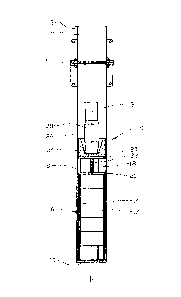Some of the information on this Web page has been provided by external sources. The Government of Canada is not responsible for the accuracy, reliability or currency of the information supplied by external sources. Users wishing to rely upon this information should consult directly with the source of the information. Content provided by external sources is not subject to official languages, privacy and accessibility requirements.
Any discrepancies in the text and image of the Claims and Abstract are due to differing posting times. Text of the Claims and Abstract are posted:
| (12) Patent: | (11) CA 2742250 |
|---|---|
| (54) English Title: | MOUSE HOLE DAMPER DEVICE |
| (54) French Title: | DISPOSITIF D'AMORTISSEMENT DE TROU DE SOURIS |
| Status: | Granted and Issued |
| (51) International Patent Classification (IPC): |
|
|---|---|
| (72) Inventors : |
|
| (73) Owners : |
|
| (71) Applicants : |
|
| (74) Agent: | SMART & BIGGAR LP |
| (74) Associate agent: | |
| (45) Issued: | 2016-11-08 |
| (86) PCT Filing Date: | 2009-10-26 |
| (87) Open to Public Inspection: | 2010-05-06 |
| Examination requested: | 2014-07-04 |
| Availability of licence: | N/A |
| Dedicated to the Public: | N/A |
| (25) Language of filing: | English |
| Patent Cooperation Treaty (PCT): | Yes |
|---|---|
| (86) PCT Filing Number: | PCT/NO2009/000369 |
| (87) International Publication Number: | WO 2010050821 |
| (85) National Entry: | 2011-04-29 |
| (30) Application Priority Data: | ||||||
|---|---|---|---|---|---|---|
|
A mouse hole damper device (1) positioned at the bottom portion (4) of a
mouse hole pipe (2), the mouse hole damper (1) being arranged to dampen an
impact
from an object (28) falling in the mouse hole pipe (2), and the mouse hole
damper (1) including
a material (36) which has been worked into forming walls around elongated
openings (34), and the material (36) being arranged in such a way that the
openings (34)
are, in the main, parallel to the longitudinal axis (13) of the mouse hole
pipe (2).
L'invention porte sur un dispositif d'amortissement de trou de souris (1), positionné à la partie inférieure (4) d'un tuyau de trou de souris (2), l'amortisseur de trou de souris (1) étant agencé de façon à amortir un impact à partir d'un objet (28) tombant dans le tuyau de trou de souris (2), et l'amortisseur de trou de souris (1) renfermant un matériau (36) qui a été travaillé sous la forme de parois de formation autour d'ouvertures allongées (34), et le matériau (36) étant agencé d'une telle manière que les ouvertures (34) sont principalement parallèles à l'axe longitudinal (13) du tuyau de trou de souris (2).
Note: Claims are shown in the official language in which they were submitted.
Note: Descriptions are shown in the official language in which they were submitted.

2024-08-01:As part of the Next Generation Patents (NGP) transition, the Canadian Patents Database (CPD) now contains a more detailed Event History, which replicates the Event Log of our new back-office solution.
Please note that "Inactive:" events refers to events no longer in use in our new back-office solution.
For a clearer understanding of the status of the application/patent presented on this page, the site Disclaimer , as well as the definitions for Patent , Event History , Maintenance Fee and Payment History should be consulted.
| Description | Date |
|---|---|
| Maintenance Request Received | 2024-09-04 |
| Maintenance Fee Payment Determined Compliant | 2024-09-04 |
| Inactive: Recording certificate (Transfer) | 2023-02-16 |
| Inactive: Recording certificate (Transfer) | 2023-01-16 |
| Inactive: Recording certificate (Transfer) | 2023-01-16 |
| Inactive: Multiple transfers | 2022-12-06 |
| Common Representative Appointed | 2019-10-30 |
| Common Representative Appointed | 2019-10-30 |
| Change of Address or Method of Correspondence Request Received | 2018-01-12 |
| Grant by Issuance | 2016-11-08 |
| Inactive: Cover page published | 2016-11-07 |
| Pre-grant | 2016-09-21 |
| Inactive: Final fee received | 2016-09-21 |
| Letter Sent | 2016-04-07 |
| Notice of Allowance is Issued | 2016-04-07 |
| Notice of Allowance is Issued | 2016-04-07 |
| Inactive: Approved for allowance (AFA) | 2016-03-31 |
| Inactive: QS passed | 2016-03-31 |
| Amendment Received - Voluntary Amendment | 2015-10-01 |
| Inactive: S.30(2) Rules - Examiner requisition | 2015-06-04 |
| Inactive: Report - No QC | 2015-05-29 |
| Letter Sent | 2014-07-14 |
| Request for Examination Received | 2014-07-04 |
| All Requirements for Examination Determined Compliant | 2014-07-04 |
| Request for Examination Requirements Determined Compliant | 2014-07-04 |
| Amendment Received - Voluntary Amendment | 2014-07-04 |
| Inactive: Cover page published | 2011-07-05 |
| Inactive: Notice - National entry - No RFE | 2011-06-21 |
| Application Received - PCT | 2011-06-20 |
| Inactive: IPC assigned | 2011-06-20 |
| Inactive: IPC assigned | 2011-06-20 |
| Inactive: First IPC assigned | 2011-06-20 |
| National Entry Requirements Determined Compliant | 2011-04-29 |
| Application Published (Open to Public Inspection) | 2010-05-06 |
There is no abandonment history.
The last payment was received on 2016-09-30
Note : If the full payment has not been received on or before the date indicated, a further fee may be required which may be one of the following
Please refer to the CIPO Patent Fees web page to see all current fee amounts.
Note: Records showing the ownership history in alphabetical order.
| Current Owners on Record |
|---|
| GRANT PRIDECO, INC. |
| Past Owners on Record |
|---|
| JAN ERIK PEDERSEN |